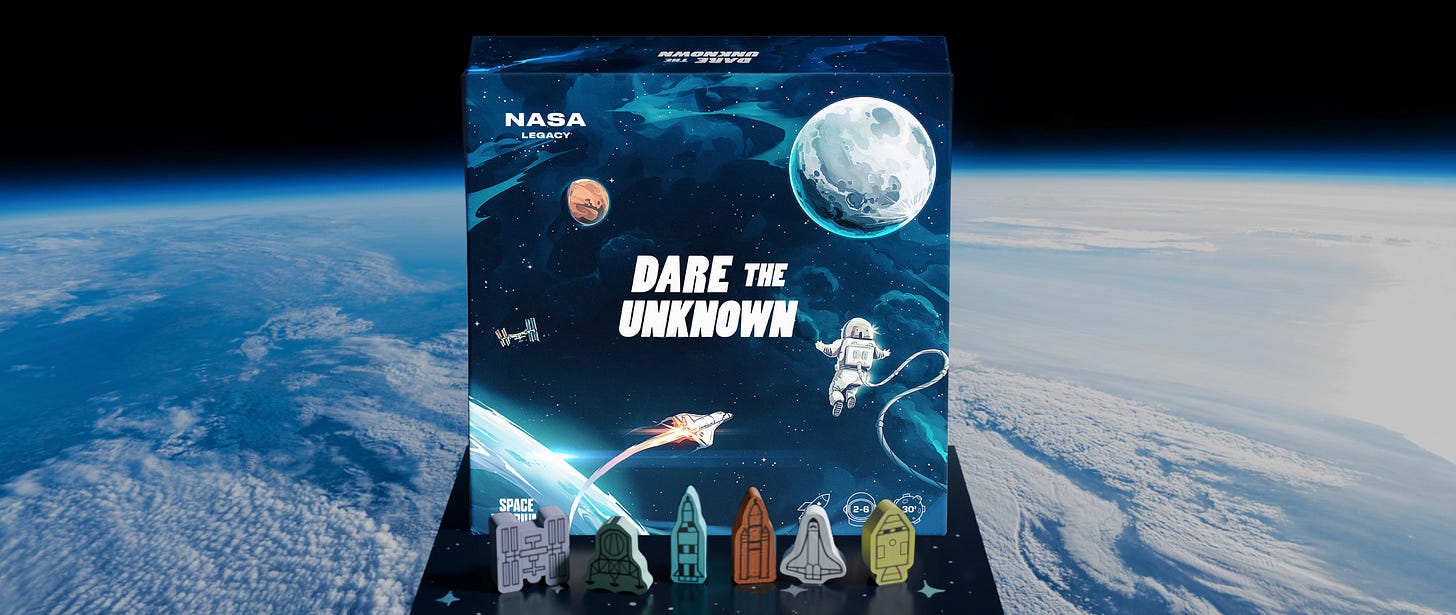Dare the Unknown: the Nasa-endorsed game with out-of-this-world aims
French design studio Space Delirium on its plans to boldly go where no board game has gone before
Can we start a magazine together?
Hello. The support of subscribers reading The Generations Games keeps me motivated; paid subscribers help me to dream bigger.
I’d love to turn The Generations Games into a full-fledged online magazine.
My day job as a sub-editor and copy-editor with years of experience in layout design on national newspapers and magazines means that I’m in a great place to do this – if time and money allows.
There will always be a free version of this newsletter. However, to help that dream become a reality, please consider upgrading your subscription. You’ll also get full access to the GG archives into the bargain. Thanks!
Space is a common theme in board gaming. At the time of writing, four of the top 10 in Board Game Geek’s charts are set in the great beyond.
However, not many can state that they’re Nasa-endorsed. The US government’s space administration did launch its own TTRPG, The Lost Universe, last year, while Buffalo Games’ 2020 release Apollo: A Game Inspired by NASA Moon Missions, gained its approval.
So, here comes Dare the Unknown, from French indie studio Space Delirium, run by twins Alexandra and William Legrand. A competitive game for two to six players, gamers will take to Earth’s orbit in one of several legendary spacecraft.
After a meeting with US embassy officials led to the game’s authorisation from Nasa, the team now have very high hopes for it – literally, as they aim for one copy to be sent to space via helium balloon.
We spoke to William about the game and its upcoming crowdfunding campaign on Gamefound.
What’s the aim of Dare the Unknown and what game mechanics does it use?
WL: The goal is to navigate Nasa’s legendary spacecraft, complete a full orbit, and return them safely to Earth.
To achieve this, players will use cards to advance their progress or hinder their opponents, adding an extra layer of strategy and interaction.
Inspired by classic strategy games like Tock, the game is designed to be fun and competitive, accessible to all ages, while also helping players become more familiar with space exploration and Nasa’s incredible history.
How did the licensing deal with Nasa come about? Who got in touch with you and what did the process involve?
WL: Our journey with Nasa started when emissaries from the US Embassy visited businesses in our area. We had the opportunity to be invited to a lunch with them and, during our discussions, we shared our desire to create a board game featuring Nasa.
During these exchanges, they informed us that Nasa’s European headquarters is based in Paris and kindly put us in contact with them. We then met with their team at their office. Following this meeting, we were introduced to Nasa HQ in the US, where we presented our vision for Dare the Unknown.
As part of the agreement, we have creative freedom in designing the game, but everything must align with Nasa’s values and mission. The goal is to create a game that is accessible to a wide audience, making space exploration exciting and engaging for everyone.
Additionally, all texts, dates and explanations must be historically accurate, and reflect the true story of Nasa. Once the content is validated, we also need to follow specific brand specifications to ensure consistency with Nasa’s identity and guidelines.
The playing piece components are based on Nasa spacecraft through the Space Age. Which craft have you used and do the different designs have any impact on the gameplay?
WL: We’ve carefully selected six legendary spacecraft that have played a crucial role in Nasa’s history: Saturn V; Space Shuttle; ISS (International Space Station); Apollo Lunar Module (LM); Artemis SLS (Space Launch System); and the Apollo Command and Service Module (CSM).
While the pieces are visually distinct to reflect the uniqueness of each spacecraft, they do not have individual gameplay abilities. This decision was made to ensure game balance and accessibility, making it easy for everyone to enjoy. However, the different shapes of the pieces were also carefully chosen to accommodate players who have difficulty distinguishing colours. This ensures that everyone, regardless of colour perception, can easily identify their pieces and fully enjoy the game.
Additionally, the selected spacecraft are all vehicles that have actually travelled or will travel into space, making them the most relevant choices for the playing pieces. Other Nasa spacecraft and vehicles that played key roles in space exploration, such as robotic probes and rovers, will be featured on the game’s cards.
What can players expect to learn about Nasa and space in general from playing the game?
WL: Through gameplay, players will become familiar with iconic Nasa spacecraft and their significance in space exploration.
To further enrich the experience, the rulebook will offer an in-depth look at Nasa’s history, showcasing its most legendary missions and its crucial role in expanding our understanding of the cosmos.
Additionally, players will gain insight into Nasa’s branding and logos, exploring their evolution and meaning.
What environmental sustainability measure are you taking in producing the game?
WL: The game will be completely plastic-free, using only paper, wood, cardboard, craft materials and corn-based cellulose.
Additionally, our add-ons will be made from metal, fabric and cardboard. Even the packaging will be 100% recyclable, ensuring minimal environmental impact.
One of our most exciting sustainability initiatives is our special tier, where we will send a copy of the game into space using a helium balloon. The balloon will be recovered and reused for a future launch, ensuring it doesn’t contribute to waste. The game will then be retrieved and sent to the backer who has pledged for this unique experience.
What are the origins of Space Delirium? Have you always created and played games together?
WL: After our studies, we knew we wanted to work together, being twins with different but complementary backgrounds felt like the perfect fit.
We noticed that many creative projects were successfully funded through crowdfunding, so we decided to test our first project: Stardust, a minimalist Tarot inspired by space. The campaign succeeded, which encouraged us to continue developing other games, always with a strong link to space.
Following Stardust, we expanded the collection with a mini version and a dice version of the game.
We then stepped out of our comfort zone and expanded into tabletop role-playing accessories, creating dice games with a sci-fi twist. Dicecovery are unique dice sets featuring either a glow-in-the-dark phosphorescent stone or a liquid core that glows in the dark.
Have you got a favourite planet?
WL: For us, it’s Mars.
Mars has had a huge influence in pop culture, from classic sci-fi books and movies to video games and comics, it has always been a planet that fuels the imagination.
Beyond that, it’s the first planet where we can actually see real photos of its surface, thanks to the incredible rovers and missions sent by Nasa and other space agencies.
It also represents the next big step in space exploration, as a planet that could one day host human life, and every new mission brings us closer to understanding its mysteries.
You previously crowdsourced Dicecovery – Fractured Universe among others. How is your experience from previous campaigns impacting this one?
WL: Our previous crowdfunding campaigns have been invaluable learning experiences, allowing us to refine our processes and improve every aspect of our work. They have helped us better structure our workflow, optimise timing and production schedules, and efficiently handle large-scale orders.
Managing high-demand campaigns has also strengthened our ability to co-ordinate with manufacturers, logistics partners, and backers, ensuring smoother fulfilment.
Thanks to these experiences, we feel more prepared than ever for this new campaign.
What are your favourite space-based tabletop games to play that aren’t your own?
WL: We love The Crew. It’s a cooperative game where players have to sacrifice their own plays for the team’s success, based on the mission objectives. It’s one of those games that completely flips your thinking and challenges how you approach teamwork. Absolutely brilliant!
And to be a little patriotic, we have to mention Ganymede.
Do you have any favourite board games you and family members enjoy playing together?
WL: Dixit is a fantastic French game that sparks creativity and imagination, making it a great choice for playing with family and friends.
The beautiful artwork and the way each player interpret the cards differently always lead unexpected moments.
When can people expect Dare the Unknown’s campaign to be launched and then in their homes if and when successful?
WL: The campaign is set to launch in mid-May, shipping is planned for January.
For more information, visit spacedelirium.com
Ryan Laukat: 'Most of my playtesting is done by my family'
The Sleeping Gods and Roam designer and illustrator on building worlds, then publishing them
Share The Generations Games? Ah, go on…
if you made it this far, you’re probably keen on family tabletop games, and games with a strong social theme. Forwarding to a like-minded friend can make a huge difference to the future of The Generations Games and our hopes to expand our output.






